St. Anton: Cradle of Austrian Skiing
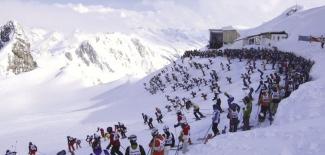
The cradle of skiing is all grown up.
(Photo top:) In most years, more than 600 skiers push off in a mass start, for a brutal five-mile, 5,000-foot descent marking the season's final run. Der Weisse Rausch race starts at 5:00pm; the piste surface has been churned and mogulled by recreational traffic all day. Ski Arlberg photo.
Under a starry sky, five skiers slowly descend a steep slope using wooden skis, lace-up leather boots and bamboo ski poles. Dressed in woolen blazers with buttons, Tyrolean-style trousers and felt hats with feathers, they employ Hannes Schneider’s Arlberg technique—a stem christie in the fall line, parallel across the hill—to maneuver the long, edgeless skis.
This flashback on snow happened during the opening ceremony of the FIS Alpine Junior World Ski Championships, staged in St. Anton am Arlberg in January 2023. I’d made the trek to Austria’s Tyrol to watch my son Aidan compete in the races—and to explore the history of the resort that calls itself the “cradle of skiing.”
Early Days
St. Anton has evolved in the 600 years since a swineherd named Heinrich Findelkind founded the Hospiz St. Christoph, which offered refuge to travelers caught in blizzards while trying to cross the Arlberg Pass. Back then, St. Anton relied on agriculture and the transport of commodities like salt and silver for its economy.
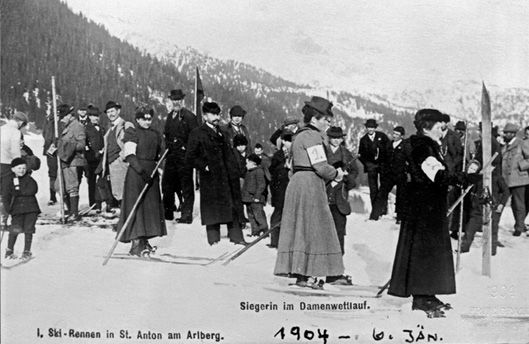 In January, 1903, the St Anton Ski Club held trial
In January, 1903, the St Anton Ski Club held trialraces for members, including women. Bad weather cancelled the "open" race in March.
“Life was really, really hard back then,” says Yannick Rumler, press officer for the Arlberg region and a history buff who shows me around the Museum of St. Anton am Arlberg. Opened in 1980, the museum is housed in the erstwhile Villa Trier, an elegant Art Nouveau chalet built around 1910 as a seasonal getaway for German industrialist and entrepreneur Bernhard Trier. One wood-paneled room is dedicated to ski equipment through the ages, from long wooden skis with Huitfeldt bindings, circa 1905, to Austrian racing champ Karl Schranz’s 1962 Kneissls to the short, shapely Salomon Equipe 10 3Vs on which Mario Matt won the 2001 slalom world championship here. Known as “der Arlberg Adler”—eagle of the Arlberg—Matt now owns the Krazy Kanguruh, a legendary St. Anton après-ski spot.) Elsewhere in the museum, displays chronicle St. Anton’s trajectory from poor farming village to booming international ski resort.
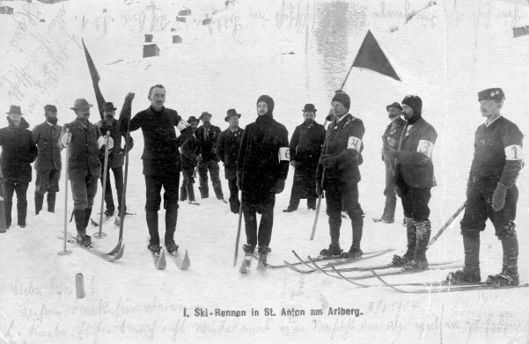 And so the first "general" race was held in 1904. The long-distance race was an uphill-downhill slog over the top of Galzig in deep snow. Yannick Rumler/Tourist Board photos
And so the first "general" race was held in 1904. The long-distance race was an uphill-downhill slog over the top of Galzig in deep snow. Yannick Rumler/Tourist Board photos
The first person to ski here may have been a Norwegian engineer who came to work on the Arlberg tunnel in the 1880s. But most sources credit Johann Müller, a priest from Warth, as the first. He ordered a pair of skis from Sweden and used them to commute to Lech. In 1901, the Ski-Club Arlberg was founded, and the first ski lessons were taught in Zürs by Viktor Sohm of Bregenz in 1906. Back then, mostly locals learned the sport.
In 1907, Hannes Schneider, St. Anton’s most famous ski legend, started teaching guests at the Hotel Post (built in 1896 by Carl Schuler) and founded the Ski School
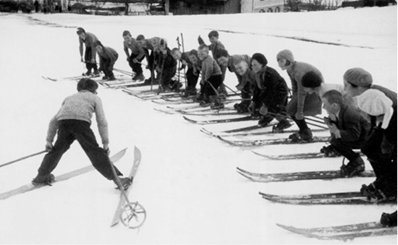 Arlberg ski school, 1921. St Anton Tourist Board/Rumler
Arlberg ski school, 1921. St Anton Tourist Board/Rumler
Arlberg in 1920. He taught his Arlberg technique all over the world, from Japan to New Hampshire. By the early 1920s, people were traveling to the Arlberg to learn to ski. Amazingly, until 1937, when Austria’s first surface lift was installed in Zürs, many of those early skiers were earning their turns by hiking up (although some did make use of a combination of a motor and toboggan that dragged skiers uphill).
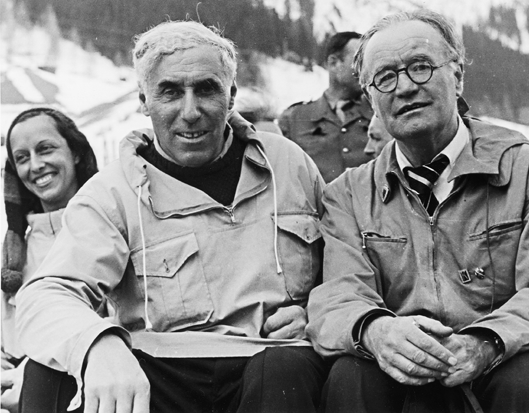 Hannes Schneider and Arnold Lunn.
Hannes Schneider and Arnold Lunn.
Schneider’s Arlberg progression was all the rage until around 1953, when another local ski instructor, Professor Stefan Kruckenhauser, introduced a novel short-swing turn
in St. Christoph, a part of St. Anton. Wedeln was a dramatic legs-glued-together, heel-thrusting kind of move.
Hints of this history play out in town, too. Inside the Great Valluga, a ski shop that opened in St. Anton in 2020, walls are lined with old hanza sticks, which farmers once used to dry out harvested hay, each branded with the family’s initials. “We want to give old stuff new life as artistic design elements,” says shop manager Philipp Traxl, whose family has been in St. Anton for four generations. The centerpiece of the shop: The front desk is a work of art made from a 175-year-old Nessler spruce with a trunk diameter of nearly four feet.
How the Railroad Changed St. Anton—Twice.
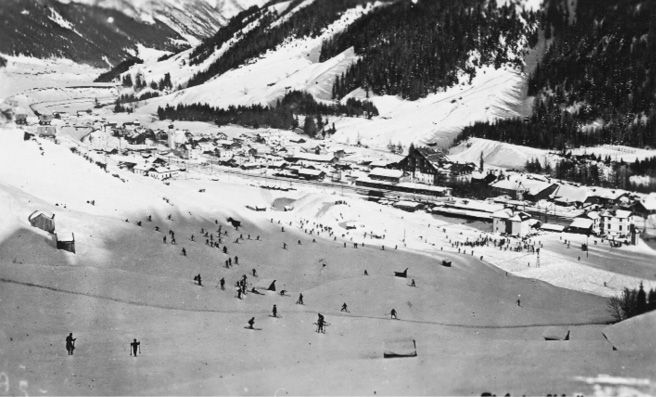 Slopes near the village were crowded by 1930, though skiers still climbed for their turns.
Slopes near the village were crowded by 1930, though skiers still climbed for their turns.
At the museum, Rumler shows me old black-and-white photos detailing the milestones that changed the face of St. Anton. In 1880, the emperor of Austria, Franz Josef, envisioned his empire connected by a railway system, including the longest tunnel in Austria. The Arlberg Railway Tunnel broke ground in 1880 and, with the aid of some 5,000 workers, took only four years to build.
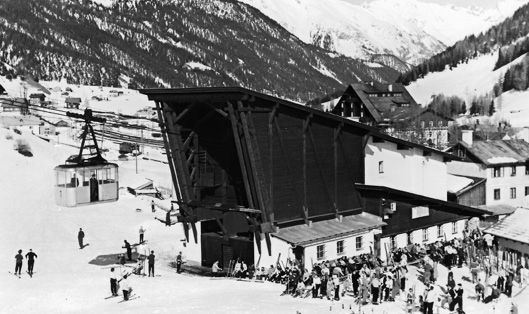 After World War I, Austria was impoverished. St Anton got its Galzigbahn in 1937, three years after trams went up in France and Switzerland.
After World War I, Austria was impoverished. St Anton got its Galzigbahn in 1937, three years after trams went up in France and Switzerland.
“It was a big accomplishment because they didn’t have any laser tracking or GPS technology,” Rumler says. St. Anton was a major stop on the railway’s east-west route from Innsbruck to Zurich, with the tracks running straight through the center of town. Climbers and skiers began flocking to the Arlberg. It was the place to be.
Over the decades, St. Anton grew in popularity, traffic increased, and trains grew longer. By the 1980s, skiers on the way to the slopes often needed to wait 20 minutes to cross the tracks. When the resort earned the bid to host the 2001 FIS Alpine World Ski Championships, organizers knew the railway was a logistical snafu. The tracks, which had run through town for a century, were rerouted to the south along the edge of the mountains, serving a brand-new station. The relocation monumentally changed the face of St. Anton. The former railway line was transformed into an open space called the Kunstmeile (art mile), a walking path lined with sculptures. The move also made way for a new race finish-line arena and WellCom, a state-of-the-art wellness and recreation center with swimming pools, saunas, a brine steam bath and an event space. The old stone train station is now a private home.
St. Anton on the Silver Screen
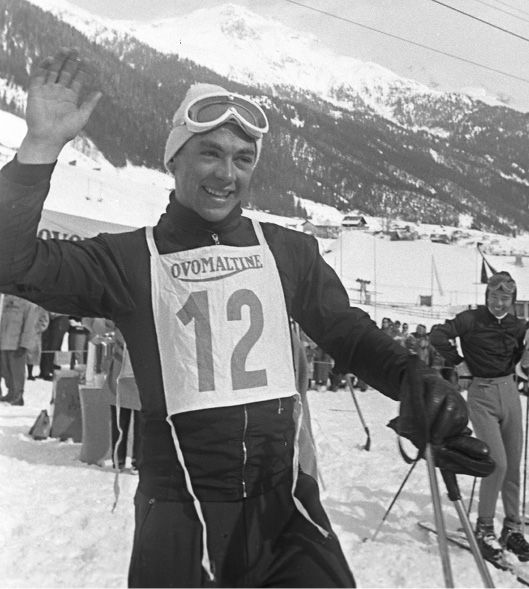 Local hero Karl Schranz won World Cup titles in 1969 and 1970.
Local hero Karl Schranz won World Cup titles in 1969 and 1970.
Call me starry-eyed, but I loved the museum’s display of movies filmed at the resort. Der Schwarze Blitz (1958) featured the skiing prowess of triple-gold Olympic champ Toni Sailer. The title is Sailer’s nickname, Black Lightning. (The name needs explanation: It could have been “Blitz from Kitz,” but local rival Anderl Molterer had an equal claim, so black-haired Sailer became Schwarze Blitz and white-haired Molterer Weisse Blitz.) In the 1967 Cold War spy thriller The Double Man, Britt Ekland, sporting a fur-trimmed jacket, is chased across the slopes of St. Anton by Yul Brynner. Arguably the best ski-racing movie of all time, Downhill Racer (1969), used footage of actual races, including Schranz at St. Anton. The movie depicts (among other races) St. Anton’s Arlberg-Kandahar race, first staged in 1928. Trier’s villa turned museum also served as the chalet in 2011’s Chalet Girl, starring Felicity Jones.
Ski chase scenes in the 1931 film Der Weisse Rausch, starring Hannes Schneider, Leni Riefenstahl and Rudi Matt, are the inspiration for one of the resort’s most thrilling modern traditions. On closing day each April, a race by that name kicks off with a mass start at the top of the 9,222-foot Valluga Mountain, with 555 skiers and snowboarders racing down a 5.6-mile long course that includes a brutal 500-foot uphill climb and 4,430 vertical feet of descent. The record time is seven minutes, nine seconds, but you’re free to do a leisurely half an hour if, for instance, you ski in a ball gown. It’s a new cult classic.
The Interconnectedness of It All
Modern resort planners had a vision to make the Arlberg the largest interconnected ski resort in Austria. The addition of the Flexenbahn gondola in December 2016 made it possible. Today, you can ski from St. Anton to Zürs to Lech to Warth and back. I join Jan and Guy Colclough, a British couple who winter in St. Anton, to ski to Lech. It’s possible to make it to Lech and back in a day, but you have to start early and ski hell for leather.
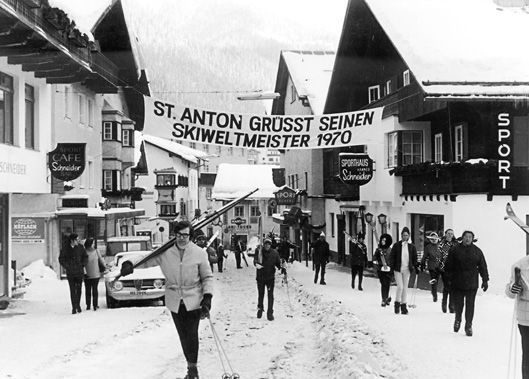 St Anton hosts the Alpine World Championships, 1970
St Anton hosts the Alpine World Championships, 1970
Guy and Jan recommend we start late, then après-ski in Lech and take the bus back to St. Anton. “We do not ski back,” Guy tells me. “The run back is just so boring above Lech.” They may be transplants, but I figure the Colcloughs are onto something. We follow the Run of Fame, an 85-kilometer ski circuit with pit stops along the way dedicated to the Arlberg’s ski pioneers and movie stars, many of whom are memorialized in a museum at the Flexenbahn’s top station. We ski past St. Christoph, Stuben and Zürs, stopping at the Trittkopf BBQ station for coffee. Originally constructed in 1962 as a lift terminal, the building now has a modern aesthetic, though the architects incorporated original elements like the massive cable supports and bull wheels. Cantilevered floor-to-ceiling windows frame the Alps, which stretch to the horizon.
A few hours later, we load the Zugerbergbahn, our 10th and final ski lift of the day. A special gondola car pulls in with a table covered in white linen and set with champagne glasses and bottles of Moët & Chandon. “This must be our car,” Jan says to the lift op. “No, ma’am. You must call ahead.” No matter. We head for the Balmalp ski hut at the top for hearty steak salads, a charcuterie board—and prosecco. We will have our bubbles.
When we finally descend into Lech, we have one last celebratory glass of prosecco at the outdoor terrace of the Hotel Krone, a backdrop I recognize from Renée Zellweger’s 2004 film Bridget Jones: The Edge of Reason. We toast to Princess Diana, who brought William and Harry here for an annual ski vacation in the early 1990s. Then we hop on the bus back to St. Anton.
History in the Hotel
At the museum, I’d seen the 12-kilogram crystal globe won in 1969 by St. Anton ski racer Gertrud Gabl. Schranz took the men’s title that year (and the next), but to see his trophies, I visit his eponymous hotel. His two World Cup globes are the centerpiece of the massive display case in the hotel’s bar. The lobby walls are plastered with photos of the racer posing with celebrities and dignitaries like Audrey Hepburn, Jean-Claude Killy and Queen Elizabeth II. Today Schranz’s wife, Evelyn, and daughters Anna, Christiane and Kathi manage the hotel. You can find them presiding over the check-in desk, running the restaurant or mingling with guests at the bar.
Haute Moments
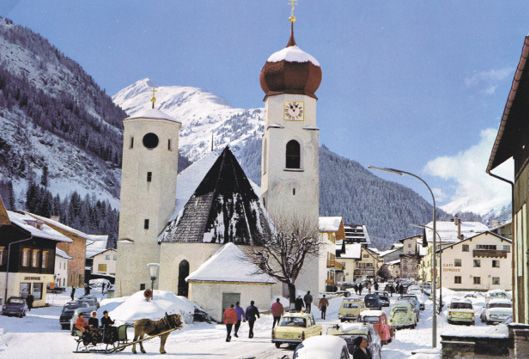 Clocktower still stands guard downtown.
Clocktower still stands guard downtown.
Between races, my son and I make the pilgrimage to the top of the Valluga, where the Tyrol meets the Vorarlberg. We ride the Galzigbahn, built in 2006 and featuring a Ferris wheel design: gondola cars enter at the top of a giant glass terminal, then rotate counterclockwise to pick up riders on the ground floor. At the top, we transfer to Vallugabahn I, a 45-person cable car built in 1954 that delivers us to Vallugabahn II, where cabins hold just five passengers. It’s like riding a telephone booth through the sky. From the top, we’re treated to spectacular 360-degree panoramas spanning five countries. It is, literally and figuratively, a high point of our trip.
That night, Aidan and I splurge on a seven-course dinner at the Alpin Gourmet Stube, a restaurant that’s earned three Gault Millau Haubens (chef hats), located inside Hotel Gletscherblick (glacier view). When founders Paula and Robert Kathrein opened the original pension in 1966, you could still see the tongue of the Hohe Riffler glacier. Today, the four-star property is run by three generations of their family. Daughter Sandra Jehle-Kathrein, along with her husband, Christian, operates the hotel with help from the granddaughters—Sophia is the patissière and Johanna works in reception and the restaurants.
As we dine on braised veal cheek and beetroot foam soup, our white-gloved waiter delivers new cutlery from a felt box with each course. Sandra sits with her 83-year-old mom at a corner table in the bar, chatting and sipping white wine. “It’s a nightly mother-daughter tradition,” Sandra
explains to me.
While the place honors its history—all three generations of women wear dirndls at dinnertime and the room keys are huge metal lumps—the family is also committed to modernizing in meaningful ways. They’ve renovated the suites with sleek, contemporary finishes and added a luxurious wellness spa with saunas, a steam bath, salt cave and a shimmering blue indoor pool.
Back at the races the next day, I marvel at the talent of today’s fastest junior racers. Benefiting from state-of-the-art equipment and wearing skintight speed suits, they hurtle expertly down St. Anton’s World Cup racecourse, including the notorious and precipitous Eisfall. In 2023, their technique is all pure carving. Hannes Schneider’s Arlberg turn? That’s history.
Boulder-based journalist and author Helen Olsson had a 10-year career at Skiing Magazine. This is her first article for Skiing History.
